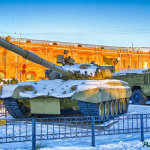On 21 March 2024 former Defence Minister Shoigu visited a military-industrial enterprise in Nizhny Novgorod region. The name of the plant was not disclosed. The management was keen to impress Shoigu. Production space had expanded, 1,100 new jobs had been created, and the workforce was working three shifts 24 hours a day. Production of the FAB-500 Glide bomb had increased several-fold and the output of FAB-1500s doubled. The factory officials were especially keen to show Shoigu their latest project: the resumption of FAB-3000 bomb production.
Voennoye Obozreniye covered the visit and reported ‘rumours’ that a universal planning and correction module (UMPC) was being developed for the FAB-3000 to convert the ordnance into a precision, glide-bomb. The journalist added ‘although this will not be easy.’ Three months later, a FAB-3000 glide-bomb made its debut in Kharkiv region. This article assesses the bomb, subsequent attacks and implications.

Characteristics of the FAB-3000-M-54
The FAB-3000-M-54 is ‘fat bomb’ with characteristic shortened body and anti-ricochet ring on the nose fairing. The design corresponds to the 1954 modification – hence the ‘54’ – and has remained in service 70 years.
The bomb has a total length of approximately 3.3 metres and case diameter of 820 mm. The stabilizer diameter is approximately 1 metre. The bomb is formed from several conical units. The head fairing has an increased thickness to allow penetration into the ground. The tail section has a stabilizer with eight planes and two rings.
The total mass of the bomb without fuses is 3,067 kilograms. The body accounts for 1,600 kilograms; the explosive weight is 1,387 kilograms. The bomb may be fitted with three fuses including point detonation and delayed action (standard for all Soviet free-fall bombs).
Lethal distances and wounding distances of FAB bombs are shown in the table below (the meaning of the ‘wounding’ distance is not clear but appears to correspond with a 10% PoK (Probability of Kill) distance).
| Bomb type | Lethal distance
(100% PoK) |
Probability of wounding |
| FAB-100 | 7.75m | 31m |
| FAB-250 | 10.12m | 40m |
| FAB-500 | 12.75m | 51m |
| FAB-1500 | 18.78m | 75m |
| FAB-3000 | 24m | 167m |
| FAB-9000 | 35m | 245m |
Source of data: Voennoye Obozreniye
The problem of accuracy
The glide module fitted to the FAB-3000 is 2.5-3 meters long and has a wingspan of about 4-5 meters. It is reportedly fitted with a jam-resistant ‘Comet satellite navigation device and a SMART navigation controller’. The UMPC can receive target coordinates in-flight. The launching aircraft can subsequently track the bomb and apparently change the target coordinates if required.
Russian defence industry only began developing glide bombs in the early 2000s. The lead company was the Moscow-based Open Joint Stock Company (OSJC) GNPP Region, a subsidiary of Tactical Missiles Corporation (KTRV). Two patents were filed: Patent No. 2247314 relating to a KAB-500 series bomb published in 2005; and Patent No. 2339905 relating to a KAB-250 published in 2008. The patents were for a ‘Roll-stabilized aircraft bomb with an inertial satellite guidance system.’
GNPP Region developed its prototype satellite-guided glide bombs over a period when precision navigation by satellite was not reliably available in Russia. In optimum conditions, GLONASS offered horizontal positioning accuracy within 5–10 metres, and vertical positioning within 15 m.
The patent for the KAB-500 series bomb described a dual air-ground guidance system with three antennas and only promised ‘ultra-high accuracy…if there is a differential reference station.’ [ground station – bold added]. This, of course, was possible on trials, but is not possible on a battlefield, hence the inaccuracy of Russian glide bombs. In fact, the GLONASS/GPS receiver supplied by Moscow’s Kompass Design Bureau only claimed an accuracy of 7m-12m, and promotional material of the period quoted a 10m Circular Error Probability.
Russian precision bombs basically cannot match Western equivalent ordnance.
Which bomber launches the FAB-3000s?
FAB-3000s were originally free-fall bombs designed to be released from Tu-22M3s and Tu-95MSs. They were used in this manner against the Azovstal works in Mariupol. Before the war, the only Russian tactical bomber certified to carry ordnance of this calibre was the veteran Su-24. The modern Su-34s have been experiencing terrible problems with the FAB-500 bombs falling off wing pylons; in the last four months, as many as 93 bombs have accidentally dropped off aircraft, mainly over Belgorod province. In the worst incident an apartment block was hit killing several people (the Russian authorities attribute these ’terrorist’ attacks to the Ukrainian armed forces).
Last year, a Russian with knowledge of the FAB-500 M62 guidance kits programme revealed ‘the frequent cases of accidental detachment of the UMPC FAB-500M62 from the carrier’ was already known. ‘During one of the test flights, he described,’ the product abnormally descended.’ The designers knew – to use the euphemism – there was a risk of ‘abnormal descent’ with FAB-500 glide bombs fitted to Su-34 wing pylons. It seems, in the usual Russian way, failure was hidden because it would be displeasing to the MOD.

Russian reporting of the first attack stated a Su-24 was involved. Subsequently, the Russian MOD released a video in which the launch aircraft is a Su-34.

The first attack
The first attack was launched on 20 June against a large, three storey building in Lyptsi (the westernmost salient on the Belgorod-Kharkiv front).


Russian reporting claimed, ‘the deviation of the FAB was no more than ten meters’, or perfectly adequate, as ‘the radius of continuous destruction of the FAB-3000 is 230 meters, and fragments retain their destructive power at a range of more than 1200 meters.’
However, drone footage shows the centre of the crater was about 20 metres from the corner of the building. It is not supposed the building corner was the Designated Mean Point of Impact (DMPI) in Western terms, but rather the centre of the building. In this case the miss distance was more in the order of 50 metres.

Subsequent attacks
Following the first attack, there were four further attacks against large buildings in the two salients on the Kharkiv-Belgorod front. As in the first attack, the bombs manifested a miss distance in the order of 50 metres.



The fourth and fifth attacks were against buildings in Vovchansk with similar outcomes.
Subsequent attacks have been reported in Slobozhanske (Kharkiv) on 24 June and 11 July; in Novgorodske (Donetsk) on 30 June; on 8 July against an unspecified air defence site; at Velyki Prokhody (Kharkiv) on 13 June; at Dzerzhinsky, Toretsk on 18 July; and at Lyptsi on 22 and 30 July. Slobozhanske was a settlement with around one thousand residents. Today, less than two dozen residents are holding on in ruins, including a woman named Lyudmilla caring for 19 cows. When the Russians last passed through the village in 2022 she told them ‘f–k you’ and ‘your retarded dwarf’ (Putin), as good an epitaph as any for the Russian president’s ‘liberation’ of Ukrainians by bombing them.
Implications
Russian designers have developed a working universal planning and correction module (UMPC) for the FAB-3000. The device is manifesting significant inaccuracy – far in excess of what would be considered acceptable in the West. The Russian command may be indifferent to this inaccuracy. The point is to demonstrate you have the big bomb – the tsar bomba. This is the Russian mentality. The first five bombs may have been trials. At the time of drafting, as many as 12 may have been launched (some of the attacks appear doubtful and may have been another bomb calibre). For context, 50-100 glide bombs are launched every day so the FAB-3000 represents much less than 1% of the bombing effort. Perhaps the bomb is stunt rather than threat.
Ukrainian defenders have proved remarkably resilient in the face of the FAB bomb attacks, as many as 800 a week as President Zelensky recently revealed. Even so, an answer must be found. To date, only the drone attacks on airfields appear to be having any effect on the intensity of Russian tactical bombing.
Sergio Miller
Sergio Miller is a retired British Army Intelligence Corps officer. He was a regular contributor and book reviewer forBritish Army Review. He is the author of a two-part history of the Vietnam War (Osprey/Bloomsbury) and is currently drafting a history of the Russian invasion of Ukraine.





